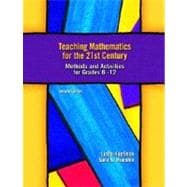
| List of Activities | |
| Prior To Entering The Classroom | |
| History and Introduction to Mathematics Education Reform | |
| Learning, Motivation, and Basic Management Skills | |
| Concrete to Abstract With Tools, Manipulatives, Computer Programs, and Calculators | |
| Standards-Based Curricula With Sample Lessons | |
| Geometry and Algebra Redefined? | |
| Teaching And Learning In The Classroom | |
| Planning Instruction | |
| Promoting Communication in the Classroom | |
| Assessing Individual Student Performance | |
| Student Equity | |
| Focus on Performance Assessment | |
| Ongoing Development | |
| Communicating With Parents and Community | |
| Professional Growth | |
| Activity Notes to the Teacher for Selected Poems | |
| References | |
| Index | |
| Table of Contents provided by Publisher. All Rights Reserved. |
The New copy of this book will include any supplemental materials advertised. Please check the title of the book to determine if it should include any access cards, study guides, lab manuals, CDs, etc.
The Used, Rental and eBook copies of this book are not guaranteed to include any supplemental materials. Typically, only the book itself is included. This is true even if the title states it includes any access cards, study guides, lab manuals, CDs, etc.